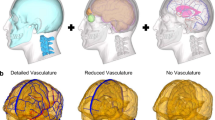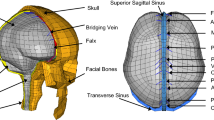Abstract
Traumatic brain injury (TBI) is a leading cause of death and disability in the USA. To help understand and better predict TBI, researchers have developed complex finite element (FE) models of the head which incorporate many biological structures such as scalp, skull, meninges, brain (with gray/white matter differentiation), and vasculature. However, most models drastically simplify the membranes and substructures between the pia and arachnoid membranes. We hypothesize that substructures in the pia–arachnoid complex (PAC) contribute substantially to brain deformation following head rotation, and that when included in FE models accuracy of extra-axial hemorrhage prediction improves. To test these hypotheses, microscale FE models of the PAC were developed to span the variability of PAC substructure anatomy and regional density. The constitutive response of these models were then integrated into an existing macroscale FE model of the immature piglet brain to identify changes in cortical stress distribution and predictions of extra-axial hemorrhage (EAH). Incorporating regional variability of PAC substructures substantially altered the distribution of principal stress on the cortical surface of the brain compared to a uniform representation of the PAC. Simulations of 24 non-impact rapid head rotations in an immature piglet animal model resulted in improved accuracy of EAH prediction (to 94 % sensitivity, 100 % specificity), as well as a high accuracy in regional hemorrhage prediction (to 82–100 % sensitivity, 100 % specificity). We conclude that including a biofidelic PAC substructure variability in FE models of the head is essential for improved predictions of hemorrhage at the brain/skull interface.













Similar content being viewed by others
References
Aimedieu P, Grebe R (2004) Tensile strength of cranial pia mater: preliminary results. J Neurosurg 100:111–114
Armstrong DL, Bagnall C, Harding JE, Teele RL (2002) Measurement of the subarachnoid space by ultrasound in preterm infants. Arch Dis Child Fetal Neonatal Ed 86:F124–F126
Barber T, Brockway J, Higgins L (1970) The density of tissues in and about the head. Acta Neurol Scand 46:85–92
Broglio S, Schnebel B, Sosnoff J, Shin S, Feng X, He X, Zimmerman J (2010) The biomechanical properties of concussions in high school football. Med Sci Sports Exerc 42:2064–2071
Bylski DI, Kriewall TJ, Akkas N, Melvin JW (1986) Mechanical behavior of fetal dura mater under large deformation biaxial tension. J Biomech 19:19–26
Cloots R, van Dommelen J, Geers M (2012) A tissue-level anisotropic criterion for brain injury based on microstructural axonal deformation. J Mech Behav Biomed Mater 5:41–52
Cloots R, van Dommelen J, Kleiven S (2013) Multi-scale mechanics of traumatic brain injury: predicting axonal strains from head loads. Biomech Model Mechanobiol 12:137–150
Cloots R, van Dommelen J, Nyberg T, Kleiven S, Geers M (2011) Micromechanics of diffuse axonal injury: influence of axonal orientation and anisotropy. Biomech Model Mechanobiol 10:413–422
Cloots RJH, Gervaise HMT, van Dommelen JAW, Geers MGD (2008) Biomechanics of traumatic brain injury: influences of the morphologic heterogeneities of the cerebral cortex. Ann Biomed Eng 36:1203–1215
Coats B, Eucker S, Sullivan S, Margulies S (2012) Finite element model predictions of intracranial hemorrhage from non-impact, rapid head rotations in the piglet. Int J Dev Neurosci 30:191–200
Coats B, Margulies S (2006a) High rate material properties of infant cranial bone and suture. J Neurotrauma 23(8):1222–1232
Coats B, Margulies S (2006b) Material properties of porcine parietal cortex. J Biomech 39:2521–2525
Couper Z, Albermani F (2008) Infant brain subjected to oscillatory loading: material differentiation, properties, and interface conditions. Biomech Model Mechanobiol 7(2):105–125
Crisco J, Fiore R, Beckwith J, Chu J, Per Gunnar B, Duma S, McAllister T, Duhaime A, Greenwald R (2010) Frequency and location of head impact exposures in individual collegiate football players. J Athl Train 45:549–559
Crisco J, Wilcox B, Beckwith J, Chu J, Duhaime A, Rowson S, Duma S, Maerlender A, McAllister T, Greenwald R (2011) Head impact exposure in collegiate football players. J Biomech 44:2673–2678
Eucker S, Smith C, Ralston J, Friess S, Margulies S (2011) Physiological and histopathological responses following closed rotational head injury depend on direction of head motion. Exp Neurol 227:79–88
Faul M, Xu L, Wald M, Coronado V (2010) Traumatic brain injury in the united states: emergency department visits, hospitalizations, and deaths. 2002–2006
Frankel DA, Fessel DP, Wolfson WP (1998) High resolution sonographic determination of the normal dimensions of the intracranial extraaxial compartment in the newborn infant. J Ultrasound Med 17:411–415
Galford J, McElhaney J (1970) A viscoelastic study of scalp, brain, and dura. J Biomech 3:211–221
Giordano C, Cloots R, van Dommelen J, Kleiven S (2014) The influence of anisotropy on brain injury prediction. J Biomech 47:1052–1059
Hagmann CF, Robertson NJ, Acolet D, Nyombi N, Ondo S, Nakakeeto M, Cowan FM (2011) Cerebral measurements made using cranial ultrasound in term ugandan newborns. Early Hum Dev 87:341–347
Higgins M, Halstead P, Snyder-Mackler L, Barlow D (2007) Measurement of impact acceleration: mouthpiece accelerometer versus helmet accelerometer. J Athl Train 42:5–10
Ji S, Ghadyani R, Bolander R, Beckwith J, Ford J, McAllister T, Flashman L, Paulsen K, Ernstrom K, Jain S, Raman R, Zhang L, Greenwald R (2014) Parametric comparisons of intracranial mechanical responses from three validated finite element models of the human head. Ann Biomed Eng 42:11–24
Jin X, Lee JB, Leung LY, Zhang L, Yang KH, King AI (2006) Biomechanical response of the bovine pia-arachnoid complex to tensile loading at varying strain-rates. Stapp Car Crash J 50:637–649
Jin X, Ma C, Zhang L, Yang K, King A, Dong G, Zhang J (2007) Biomechanical response of the bovine pia-arachnoid complex to normal traction loading at varying strain rates. Stapp Car Crash J 51:115–125
Jin X, Ma C, Zhang L, Yang KH, King AI (2007) Biomechanical response of the bovine pia-arachnoid complex to normal traction loading at varying strain rates. Stapp Car Crash J 51:115–126
Jin X, Yang KH, King AI (2011) Mechanical properties of bovine pia-arachnoid complex in shear. J Biomech 44:467–474
Kuijpers A, Claessens M, Sauren A (1995) The influence of different boundary conditions on the response of the head to impact: a two-dimensional finite element study. J Neurotrauma 12:715–724
Lam WWM, Ai VHG, Wong V, Leong LLY (2001) Ultrasonographic measurement of subarachnoid space in normal infants and children. Pediatr Neurol 25:380–385
Ma C, Jin X, Zhang J, Huang S (2008) Development of the pia-arachnoid complex finite element model. Bioinformatics and Biomedical Engineering, ICBBE, the 2nd International Conference. Shanghai, China
McAllister T, Ford J, Ji S, Beckwith J, Flashman L, Paulsen K, Greenwald R (2011) Maximum principal strain and strain rate associated with concussion diagnosis correlates with changes in corpus callosum white matter indices. Ann Biomed Eng 10:127–140
Monson KL, Goldsmith W, Barbaro NM, Manley GT (2005) Significance of source and size in the mechanical response of human cerebral blood vessels. J Biomech 35:737–744
Nahum A, Smith R (1977) Intracranial pressure dynamics during head impact. Proceedings of the 21st stapp car crash conference. SAE Paper No. 770922
Pang Q, Lu X, Gregersen H, von Oettingen G, Astrup J (2001) Biomechanical properties of porcine cerebral bridging veins with reference to the zero-stress state. J Vasc Res 38:83–90
Paolini B, Danelson K, Geer C, Stitzel J (2009) Pediatric head injury prediction: investigating the distance between the skull and the brain using medical imaging. Biomed Sci Inst 45:161–166
Persson C, Evans S, Marsh R, Summers JL, Hall RM (2010) Poisson’s ratio and strain rate dependency of the constitutive behavior of spinal dura mater. Ann Biomed Eng 38:975–983
Prange M, Margulies S (2002) Regional, directional, and age-dependent properties of brain undergoing large deformation. J Biomech Eng 124:244–252
Roth S, Raul JS, Willinger R (2008) Biofidelic child head fe model to simulate real world trauma. Comput Methods Prog Biomed 90:262–274
Sabet A, Christoforou E, Zatlin B, Genin G, Bayly P (2008) Deformation of the human brain induced by mild angular head acceleration. J Biomech 41(2):307–315
Scott G (2014) Anatomy and biomechanics of the pia-arachnoid complex. Mechanical Engineering, University of Utah, Salt Lake City
Scott G, Coats B (2015) Microstructural characterization of the pia-arachnoid complex using optical coherence tomography. IEEE Trans Med Imag
Sullivan S, Eucker SA, Gabrieli D, Bradfield C, Coats B, Maltese M, Lee JY, Smith C, Margulies S (2015) White matter tract oriented deformation predicts traumatic axonal brain injury and reveals rotational direction-specific vulnerabilities. Biomech Model Mechanobiol 14(4):877–896
Takhounts E, Ridella S, Hasija V, Tannous R, Campbell J, Malone D, Danelson K, Stitzel J, Rowson S, Duma S (2008) Investigation of traumatic brain injuries using the next generation of simulated injury monitor (simon) finite element head model. Stapp Car Crash J 52:1–31
Wittek A, Omori K (2003) Parametric study of effects of brain-skull boundary conditions and brain material properties on responses of simplified finite element brain model under angular acceleration impulse in sagittal plane. JSME Int J Ser C Mech Syst Mach Elem Manuf 46:1388–1399
Wright R, Post A, Hoshizaki B, Ramesh K (2013) A multiscale computational approach to estimating axonal damage under inertial loading of the head. J Neurotrauma 30:102–118
Wright R, Ramesh K (2012) An axonal strain injury criterion for traumatic brain injury. Biomech Model Mechanobiol 11:245–260
Zhang L, Bae J, Hardy W, Monson K, Manley G, Goldsmith W, Yang K, King A (2002) Computational study of the contribution of the vasculature on the dynamic response of the brain. Stapp Car Crash J 46:145–163
Zhang L, Yang K, Dwarampudi R, Omori K, Li T, Chang K, Hardy W, Khalil T, King A (2001) Recent advances in brain injury research: a new human head model development and validation. Stapp Car Crash J 45:369–394
Zoghi-Moghadam M, Sadegh A (2009) Global/local head models to analyze cerebral blood vessel rupture leading to asdh and sah. Comput Methods Biomech Biomed Eng 12:1–12
Acknowledgments
The authors would like to thank the Primary Children’s Medical Center Foundation Early Career Award for their financial support of this work.
Author information
Authors and Affiliations
Corresponding author
Ethics declarations
Funding
This study was funded by the Primary Children’s Medical Center Foundation.
Conflict of Interest
All authors have no conflicts of interest to report
Rights and permissions
About this article
Cite this article
Scott, G.G., Margulies, S.S. & Coats, B. Utilizing multiple scale models to improve predictions of extra-axial hemorrhage in the immature piglet. Biomech Model Mechanobiol 15, 1101–1119 (2016). https://doi.org/10.1007/s10237-015-0747-0
Received:
Accepted:
Published:
Issue Date:
DOI: https://doi.org/10.1007/s10237-015-0747-0




